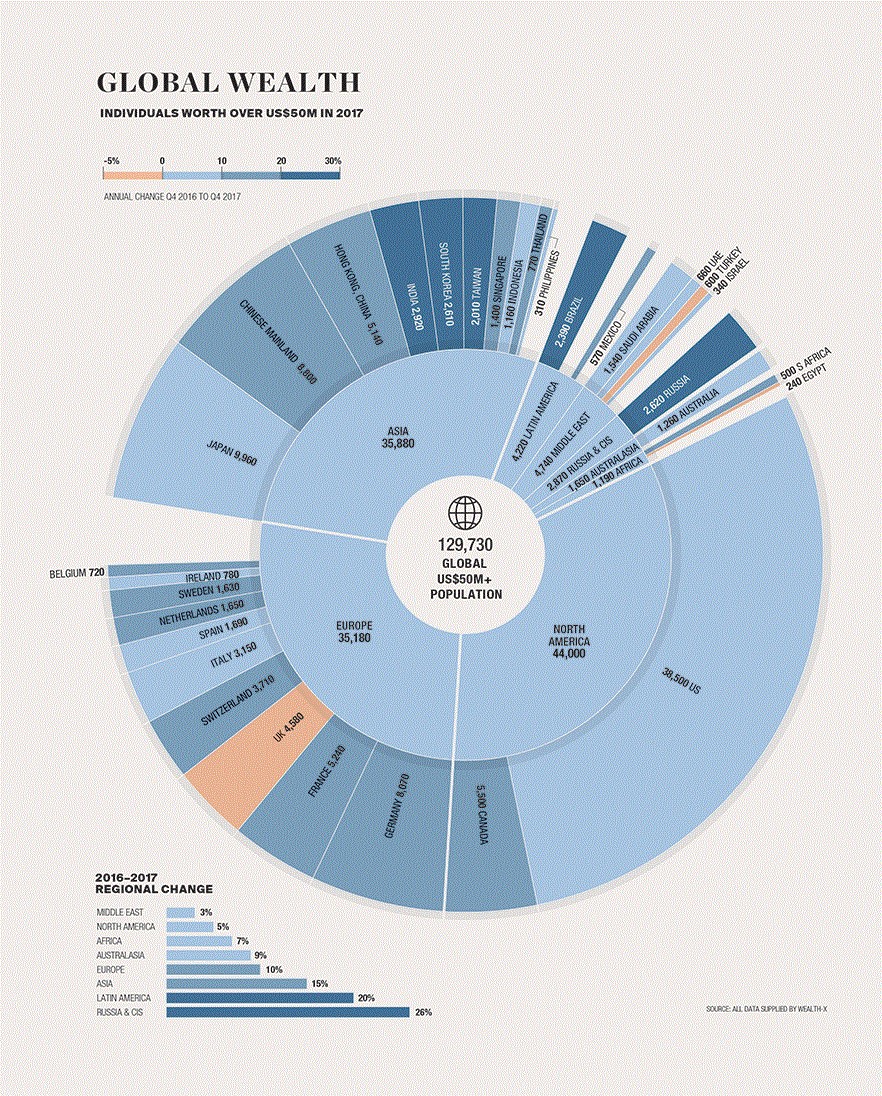The momentum of the global economy since the start of 2017 has been enough for Goldman Sachs’ to describe 2018 “as good as it gets”, and while the super-rich population is still rising, Asia is the hottest growth spot, and China is leading the mega-wealth push.
Over the next five years, China will see its ultra-wealthy population more than double, according to Wealth-X.

(Click to enlarge)
Between 2012 and 2017, according to Knight Frank’s interpretation of data, the number of people with $50 million or more in net assets rose by 31 percent in North America, 37 percent in Asia-Pacific and only 10 percent in Europe.
In Latin America and the Caribbean, the ultra-wealthy population declined by 22 percent, and in Russia and the Commonwealth of Independent States (CIS) region, they lost 37 percent.
But in 2017, things started to change a bit. Russia/CIS gained back 26 percent, with Russia coming out of a recession.
And while North America, home to some 35 percent of the world’s ultra-wealthy, is still the biggest, China is threatening to close in—fast. Europe was second until last year, when it lost its spot to Asia.
Last year saw a 15-percent rise in Asia’s ultra-rich population, but it’s the next five years that will be game-changing.
For 2017-2022, Knight Frank consultants see a 104-percent rise in China’s ultra-wealthy population, with second place going to the Philippines, which is expected to see an 84-percent increase. Related: Markets Slide Sideways As Trade War Fears Linger
India is third, with a 71-percent expected rise, followed by Indonesia with 66 percent, Malaysia with 65 percent and Japan with 51 percent.
In that same time period, the U.S. is expected to see a 38-percent rise in its ultra-wealthy population, assuming current economic forecasts.
“We have been experiencing ‘Goldilocks’ economic conditions: not too hot, and not too cold. These make it easier to do business, provide a good environment to raise capital and, above all, encourage entrepreneurialism—the key to wealth creation,” noted Vincent White, managing director of Wealth-X.
Beyond the next five years, North America’s top slot seems secure, but Europe is left behind:

(Click to enlarge)
The ultra-rich hold their wealth primarily in private and public investments, with an estimated 9 percent (around $2.7 trillion) in real estate and luxury assets, as of the end of 2016.
And as they grow, they spend, with Business Insider recently detailing the $234 billion the world’s richest spend on luxury goods every year.
• $45 billion a year on travel and hospitality
• $40 billion a year on cars
• $25 billion a year on jewelry and watches
• $25 billion a year on art
• $23 billion a year on private aviation
• $22 billion a year on yachts
• $15 billion a year on apparel
• $12 billion a year on ‘accessories’
• $8 billion a year on home goods
• $8 billion a year on wine and spirits
• $7 billion a year on food
• $4 billion a year on beauty
By Fred Dunkley for Safehaven.com
More Top Reads From Safehaven.com:

















